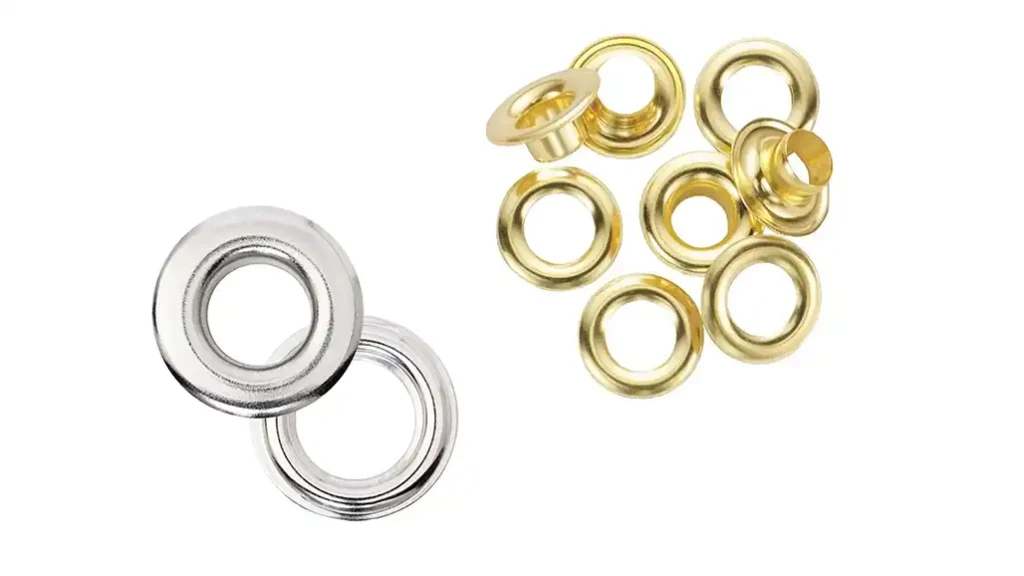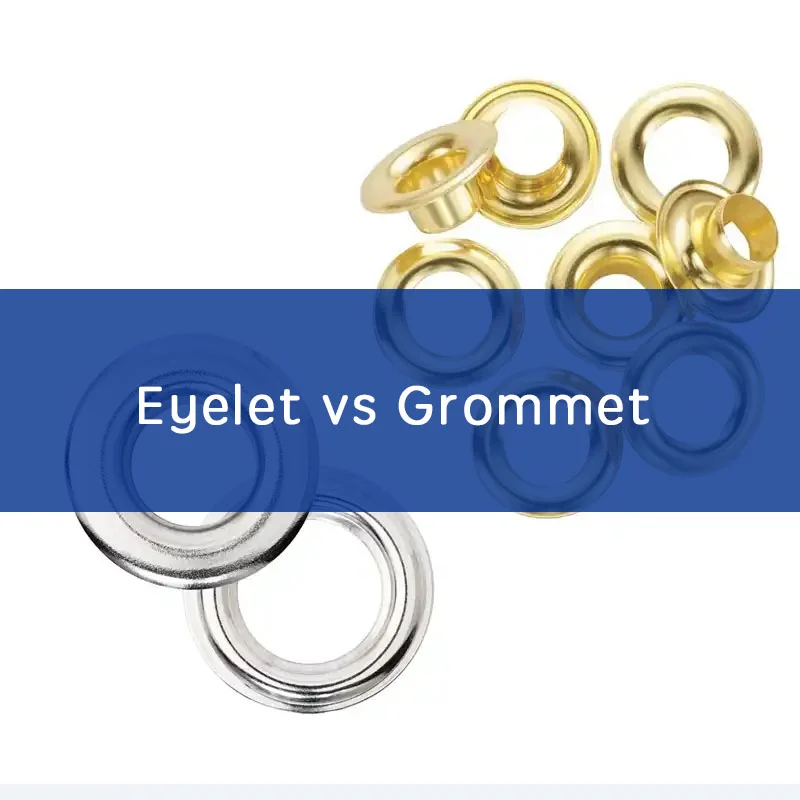When it comes to fastening materials in a variety of projects, eyelets and grommets are two essential components that often get confused due to their similar appearance. However, understanding the differences between them is crucial for achieving the desired outcome in your work.
Eyelets and grommets each serve distinct purposes, and their applications can range from delicate crafts to heavy-duty industrial tasks. By exploring the unique characteristics and uses of eyelets and grommets, you can make informed decisions that enhance both the functionality and aesthetics of your projects.
In this blog post, we will delve into the specific differences between eyelets and grommets, helping you to choose the right tool for your needs.
What Is An Eyelet
An eyelet is a small ring or edge reinforcement, typically made of metal or plastic, that is inserted into a hole in a material such as fabric, leather, or paper.
Its primary function is to prevent the material from fraying or tearing around the hole, thereby increasing its durability and providing a finished look. Eyelets are commonly used in clothing, shoes, and various craft projects to create laced or threaded closures. They are crimped into place using an eyelet setter or similar tool, ensuring they are securely fastened to the material.
What Is A Grommet
A grommet is a ring or edge strip inserted into a hole in a material to protect, strengthen, or insulate the hole’s edges.
Typically made of metal, plastic, or rubber, grommets are more robust than eyelets and are used in applications that require greater durability and reinforcement. They consist of two parts: a metal ring and a washer, which together provide a strong, secure fastening solution.
Grommets are commonly used in heavier materials such as canvas, tarps, and industrial fabrics, making them ideal for items like banners, sails, and various types of outdoor gear. Their design helps to prevent tearing and wear, ensuring the longevity of the material around the hole.
Eyelet vs Grommet

Eyelets and grommets, though similar in appearance, serve different purposes and are suited to different applications. Understanding the differences between eyelets and grommets can help you choose the right component for your project.
Eyelets
- Material: Typically made of metal or plastic.
- Design: Consists of a single piece.
- Usage: Commonly used in clothing, shoes, and lightweight crafts.
- Installation: Crimped into place using an eyelet setter or similar tool.
- Purpose: Primarily for aesthetic purposes and to prevent fraying in lighter materials.
Grommets
- Material: Usually made of metal, but can also be plastic or rubber.
- Design: Consists of two parts: a ring and a washer.
- Usage: Used in heavier materials like canvas, tarps, and industrial fabrics.
- Installation: Requires a grommet setter and a washer to secure the grommet.
- Purpose: Provides strong reinforcement and prevents tearing in heavy-duty applications.
Comparison Table
| Feature | Eyelet | Grommet |
|---|---|---|
| Material | Metal or plastic | Metal, plastic, or rubber |
| Design | Single piece | Two parts (ring and washer) |
| Typical Usage | Clothing, shoes, lightweight crafts | Canvas, tarps, industrial fabrics |
| Installation | Crimped with an eyelet setter | Requires grommet setter and washer |
| Purpose | Aesthetic, prevents fraying | Strong reinforcement, prevents tearing |
| Durability | Suitable for light use | Suitable for heavy-duty use |
| Strength | Less robust | More robust and durable |
Choosing the Right Component
- For Light-Duty Projects: Eyelets are ideal for projects where aesthetics are important and the material is not subject to heavy wear and tear. Examples include clothing, fashion accessories, and light crafts.
- For Heavy-Duty Projects: Grommets are the better choice for applications that require strength and durability. They are perfect for outdoor gear, banners, sails, and other items that need to withstand harsh conditions and heavy use.
By understanding the differences between eyelets and grommets, you can make more informed decisions and ensure the success and longevity of your projects.
How to Choose Eyelet and Grommet
Choosing between eyelets and grommets depends on several factors, including the type of material, the intended use of the project, the desired aesthetic, and the level of durability required. Here’s a guide to help you make the right choice:
Consider the Material
- Lightweight Materials: For fabrics such as cotton, silk, or lightweight leather, eyelets are generally suitable. They provide a neat, clean finish without adding significant weight.
- Heavyweight Materials: For sturdy materials like canvas, tarps, or industrial fabrics, grommets are preferable. They offer the reinforcement needed to prevent tearing and withstand stress.
Assess the Intended Use
- Aesthetic Projects: If the primary concern is appearance, such as in fashion items, accessories, or decorative crafts, eyelets are often the better choice. They add a polished look to garments and other light-duty items.
- Functional Projects: For items that need to endure wear and tear or outdoor conditions, such as banners, sails, or protective covers, grommets provide the necessary strength and durability.
Installation Process
- Ease of Installation: Eyelets are generally easier to install, requiring just an eyelet setter. This makes them suitable for DIY projects and smaller-scale applications.
- Professional Finish: Grommets require a grommet setter and washer, which can be more complex to install but result in a more secure and professional finish. This is ideal for commercial and industrial projects.
Durability Requirements
- Light Use: For items that won’t be subjected to significant stress, eyelets are adequate. They are perfect for applications where the material is not likely to be pulled or strained.
- Heavy Use: For applications where the material will be under tension or exposed to harsh conditions, grommets are essential. They provide the robustness needed to ensure longevity and reliability.
Aesthetic Preferences
- Appearance: If the look of the fastener is important, choose eyelets for their sleek, unobtrusive design. They come in various colors and finishes to match your project.
- Industrial Look: Grommets, often larger and more noticeable, provide an industrial, sturdy appearance. They can also be chosen for their visual appeal in projects where a rugged look is desired.
Cost Considerations
- Budget-Friendly: Eyelets are generally less expensive and simpler to install, making them a cost-effective choice for smaller or less demanding projects.
- Long-Term Investment: While grommets may be more costly and require more effort to install, their durability can save money in the long run for projects needing reliable and long-lasting fasteners.
By carefully considering these factors, you can choose the appropriate eyelet or grommet to enhance both the functionality and appearance of your project.
Conclusion
Understanding the differences between eyelets and grommets is crucial for selecting the right fastening solution for your projects. Eyelets, with their sleek design and ease of installation, are ideal for lightweight materials and aesthetic applications such as clothing and decorative crafts. On the other hand, grommets offer robust reinforcement for heavy-duty materials, making them perfect for outdoor gear, industrial fabrics, and applications that require extra durability and strength.
By choosing the appropriate component, you ensure that your project not only looks good but also performs well under its intended conditions. Whether you’re working on a delicate fashion item or a rugged outdoor tarp, knowing when to use an eyelet versus a grommet can make all the difference.
Ready to start your next project with the perfect fasteners? Explore our wide selection of eyelets and grommets to find the ideal match for your needs. Visit our online store or contact our experts for personalized advice and tips on how to get the best results. Make your projects shine with the right tools today!

